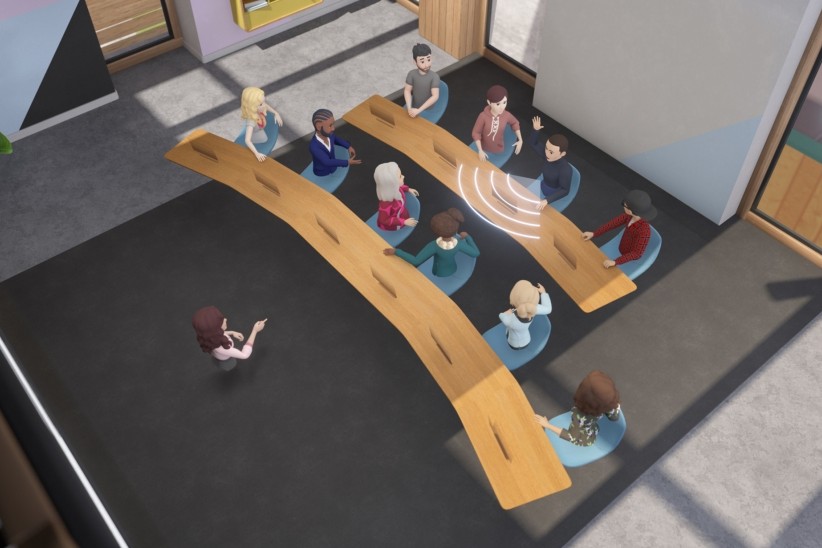Our research shows that while overall worker satisfaction is encouraging, leaders still need to address concerns – including a growing gulf between desk and non-desk workers.
September 28, 2022
Future of Work
Inclusive Futures
Wellbeing
Today’s workers face a number of challenges that have grown in significance due to shifts that began with, or were accelerated by, Covid-19. That’s one finding from our extensive research, The Global Workforce of the Future 2022, in which we surveyed 34,200 respondents (both desk- and non-desk-based workers) across 25 countries.
The past two editions of this report, from May 2020 and May 2021, focused on the shifts in working practices that emerged from the onset and continuation of the global pandemic among desk workers.
As the world attempts to step out of the pandemic’s shadow, it’s important that leaders study how working practices, behaviours and attitudes continue to evolve—and to uncover new insights on what the future world of work can and should look like for all workers, including those who are not at desks.
To that end, we’ll highlight some noteworthy findings and recommendations.
Despite overall satisfaction, workers feel their needs and priorities are not being met. That’s creating tensions that threaten talent retention.
After undergoing dramatic change brought on by the pandemic, work conditions have generally stabilised. Overall, 69% of workers say they are satisfied with their jobs (an uptick from 2021’s 67%), with non-desk workers reporting lower satisfaction than desk workers. In particular, non-desk workers are significantly less satisfied with their ability to maintain mental health and wellbeing than desk workers (52% vs. 65%).
The past two editions of this report, from May 2020 and May 2021, focused on the shifts in working practices that emerged from the onset and continuation of the global pandemic among desk workers.
As the world attempts to step out of the pandemic’s shadow, it’s important that leaders study how working practices, behaviours and attitudes continue to evolve—and to uncover new insights on what the future world of work can and should look like for all workers, including those who are not at desks.
To that end, we’ll highlight some noteworthy findings and recommendations.
How workers view the world of work
Despite overall satisfaction, workers feel their needs and priorities are not being met. That’s creating tensions that threaten talent retention.
After undergoing dramatic change brought on by the pandemic, work conditions have generally stabilised. Overall, 69% of workers say they are satisfied with their jobs (an uptick from 2021’s 67%), with non-desk workers reporting lower satisfaction than desk workers. In particular, non-desk workers are significantly less satisfied with their ability to maintain mental health and wellbeing than desk workers (52% vs. 65%).
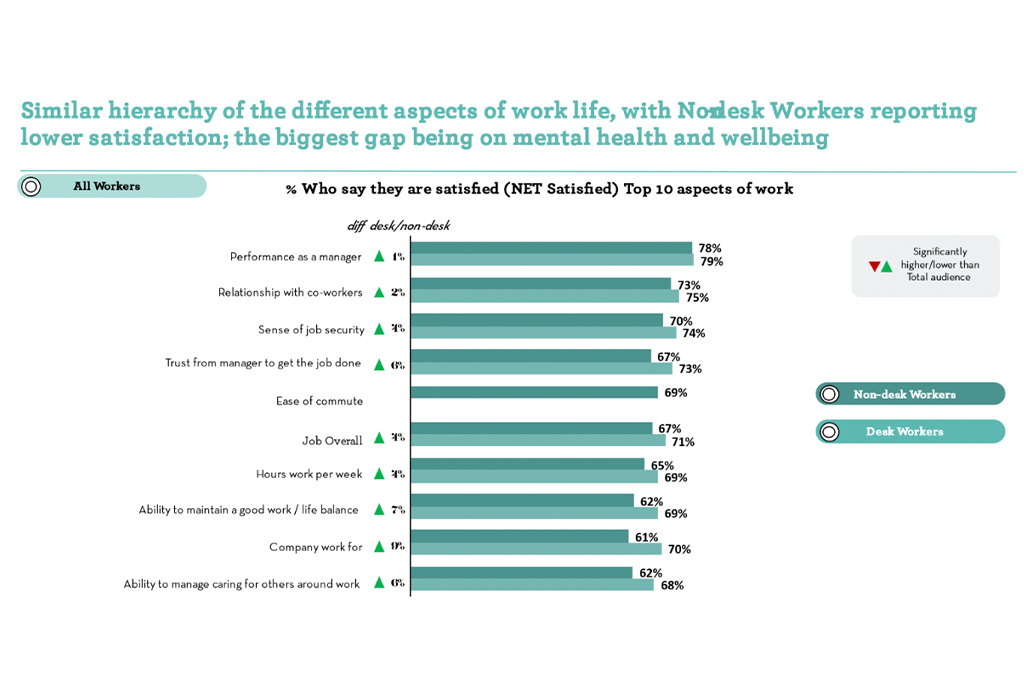
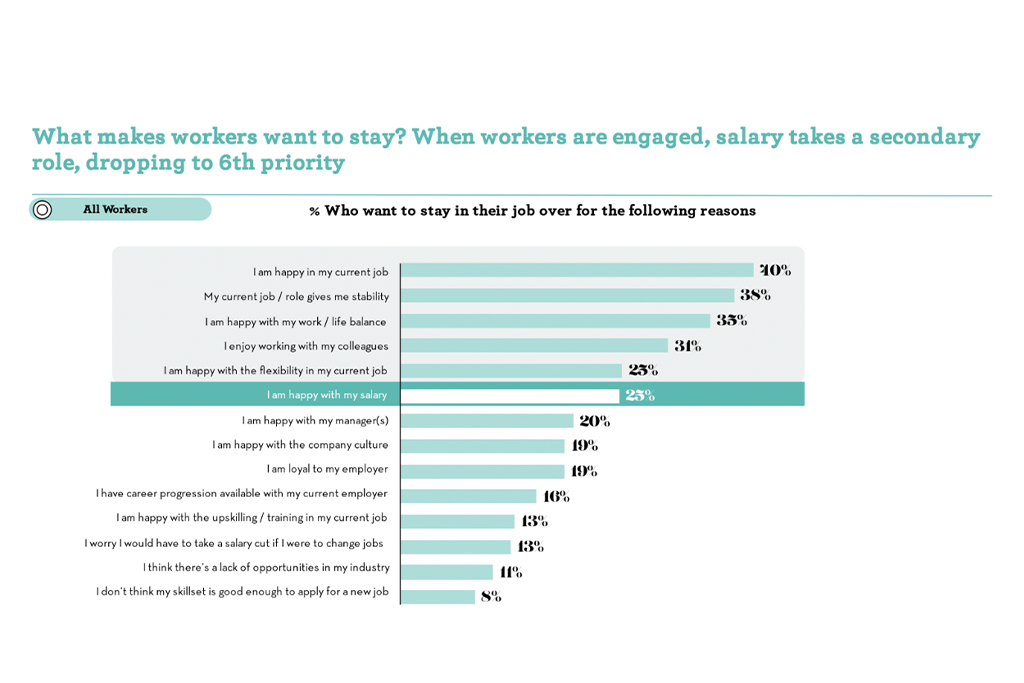
Despite these apparently strong satisfaction scores, significant numbers of workers are re-evaluating their working life—and are, in doing so, influencing co-workers to do the same. We found that when workers see colleagues quitting, 70% consider following suit and 50% actually take action.
We call this the rise of the ‘quitfluencer’. Countries most exposed to the risk of the quitfluencer phenomenon are those with the highest numbers of workers most likely to resign. Workers are most likely to leave their jobs in Australia (33%), Switzerland (32%) and in Eastern Europe, Middle East and North Africa (31%). Globally, Gen Z are 2.5 times more likely to be influenced to quit than Baby Boomers.
Why are workers leaving their jobs? They expressed needs that are going unmet by employers, including salary; flexibility; career progression and upskilling; and mental health and wellbeing.
Interestingly, in spite of today’s glum economic situation and geopolitical unrest, workers continue to believe they have power over companies in choosing where to work. Globally, 72% are not concerned about losing their job. That’s a significant increase over the 2021 figure of 61%.
Another reason workers may not feel threatened is that many are being actively wooed; of those who say they’ll quit in the next 12 months, nearly one fifth are already being recruited by headhunters or competitors (17%). So, it’s little wonder that 61% are confident they could find a new job in six months or less.
As a whole, these results indicate that the Great Reevaluation is not over by any means. It’s crucial that companies listen to workers’ call and implement solid retention strategies to keep their talent in house and motivated.
During the Great Reevaluation and pandemic lockdowns, there was a great deal of discussion about workers reexamining their priorities and deciding that money was not, or should not be, an overriding factor in their lives.
That’s all well and good, but make no mistake: our research shows that salary is an important driver for all workers. It’s a convenient way to define success—to keep score, essentially—and was a key criterion for workers when considering taking a new job. Of those who say they will quit in the next 12 months, 45% will do so in order to get a better salary.
Naturally, salary is important in talent attraction. But salary is hardly the only factor affecting workers’ attitudes; among those who feel engaged in their jobs, its rank on a list of priorities drops all the way to sixth. Only 25% of those planning to remain in their jobs cite salary as the reason. Instead, stability, work-life balance and flexibility help retain workers.
We call this the rise of the ‘quitfluencer’. Countries most exposed to the risk of the quitfluencer phenomenon are those with the highest numbers of workers most likely to resign. Workers are most likely to leave their jobs in Australia (33%), Switzerland (32%) and in Eastern Europe, Middle East and North Africa (31%). Globally, Gen Z are 2.5 times more likely to be influenced to quit than Baby Boomers.
Why are workers leaving their jobs? They expressed needs that are going unmet by employers, including salary; flexibility; career progression and upskilling; and mental health and wellbeing.
Interestingly, in spite of today’s glum economic situation and geopolitical unrest, workers continue to believe they have power over companies in choosing where to work. Globally, 72% are not concerned about losing their job. That’s a significant increase over the 2021 figure of 61%.
Another reason workers may not feel threatened is that many are being actively wooed; of those who say they’ll quit in the next 12 months, nearly one fifth are already being recruited by headhunters or competitors (17%). So, it’s little wonder that 61% are confident they could find a new job in six months or less.
As a whole, these results indicate that the Great Reevaluation is not over by any means. It’s crucial that companies listen to workers’ call and implement solid retention strategies to keep their talent in house and motivated.
Salary and inflation
During the Great Reevaluation and pandemic lockdowns, there was a great deal of discussion about workers reexamining their priorities and deciding that money was not, or should not be, an overriding factor in their lives.
That’s all well and good, but make no mistake: our research shows that salary is an important driver for all workers. It’s a convenient way to define success—to keep score, essentially—and was a key criterion for workers when considering taking a new job. Of those who say they will quit in the next 12 months, 45% will do so in order to get a better salary.
Naturally, salary is important in talent attraction. But salary is hardly the only factor affecting workers’ attitudes; among those who feel engaged in their jobs, its rank on a list of priorities drops all the way to sixth. Only 25% of those planning to remain in their jobs cite salary as the reason. Instead, stability, work-life balance and flexibility help retain workers.
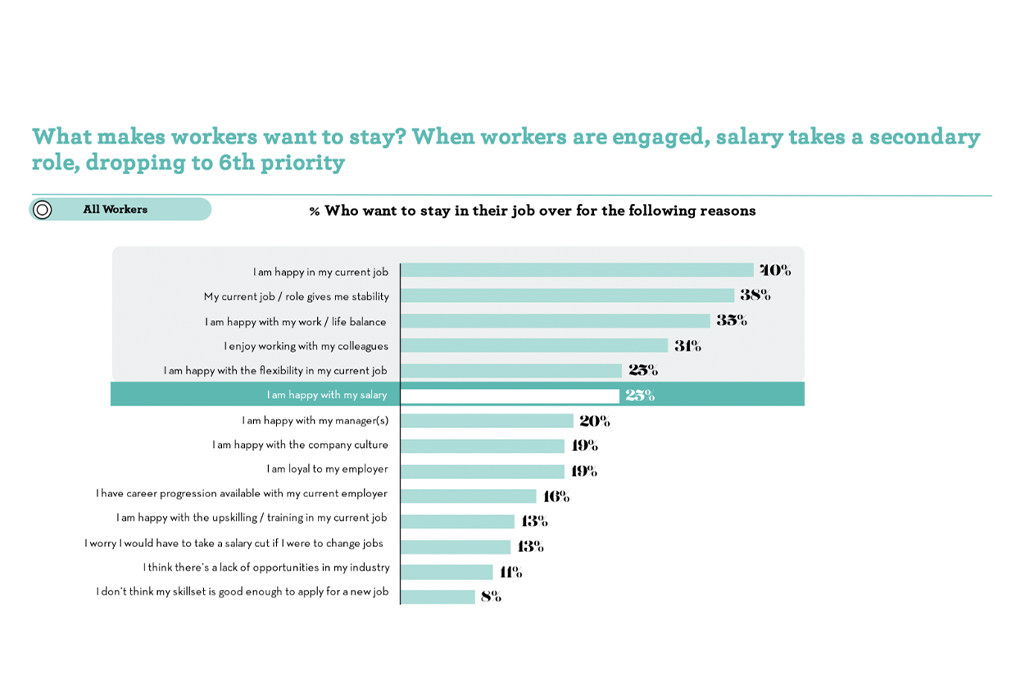
While half of all workers have received a raise in the past two years (with the U.S. and China leading the way, and Japan and Europe lagging), a disconnect is emerging between managers and non-managers. About 60% of the former group got a raise, compared to only about 40% of the latter. So it’s little wonder that non-managers seem to feel left out and are much more likely to view salary as a primary reason to change jobs (52% versus 37% of managers).
Inflation is not helping the situation, to say the least, as we recently discussed in detail. Six in ten workers fear their salary isn’t high enough to deal with current inflation rates, with Millennial and Gen Z workers the most anxious. And here the divide between desk and non-desk workers really begins to emerge. Just over half (51%) of non-desk workers say they’re looking for a second job to help make ends meet. Moreover, 35% admit they have worked cash-in-hand – or under the table.
Inflation is making talent retention more challenging for companies—causing workers to fret and shift their priorities.
During the pandemic, flexibility became a vital retention component for employers seeking to keep top desk-worker talent. In a post-Covid world, the ability to work from a wide variety of locales and devices has been woven into the very concept of work for these desk workers—especially younger ones. These priorities showed up in our 2020 and 2021 reports, and the trend continues this year.
It’s important to note, though, that the term “flexibility” is often used as shorthand for a solution to systemic issues holding back women in the workplace—while in reality, as we have written, merely offering a four-day week or job-sharing does not address the gender pay gap, workplace discrimination, women’s lack of representation in higher-level positions, or other deep-rooted problems.
Moreover, flexibility is a luxury not available to all workers. Only three out of ten non-desk workers would compromise on salary in order to increase flexibility. This is just one illustration of a troubling divide between desk and non-desk workers that really emerged in our 2022 study.
Inflation is not helping the situation, to say the least, as we recently discussed in detail. Six in ten workers fear their salary isn’t high enough to deal with current inflation rates, with Millennial and Gen Z workers the most anxious. And here the divide between desk and non-desk workers really begins to emerge. Just over half (51%) of non-desk workers say they’re looking for a second job to help make ends meet. Moreover, 35% admit they have worked cash-in-hand – or under the table.
Inflation is making talent retention more challenging for companies—causing workers to fret and shift their priorities.
Flexibility
During the pandemic, flexibility became a vital retention component for employers seeking to keep top desk-worker talent. In a post-Covid world, the ability to work from a wide variety of locales and devices has been woven into the very concept of work for these desk workers—especially younger ones. These priorities showed up in our 2020 and 2021 reports, and the trend continues this year.
It’s important to note, though, that the term “flexibility” is often used as shorthand for a solution to systemic issues holding back women in the workplace—while in reality, as we have written, merely offering a four-day week or job-sharing does not address the gender pay gap, workplace discrimination, women’s lack of representation in higher-level positions, or other deep-rooted problems.
Moreover, flexibility is a luxury not available to all workers. Only three out of ten non-desk workers would compromise on salary in order to increase flexibility. This is just one illustration of a troubling divide between desk and non-desk workers that really emerged in our 2022 study.
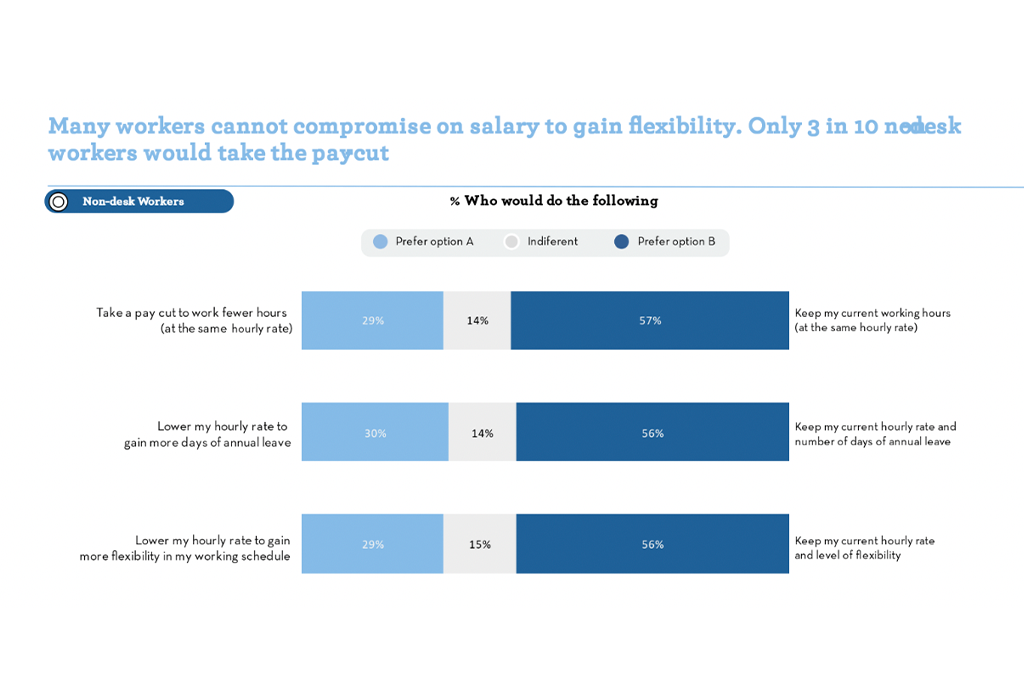
We believe there’s an opportunity for businesses to implement new ways of working based on technological solutions that could foster flexibility for all workers, helping to close this desk/non-desk gap. Tech could play a major role in allowing non-desk workers to work from new locales by, for example, increasing the ability to control factory-floor tools remotely. At the same time, automation promises to handle more and more rote, repetitive tasks, allowing non-desk workers to be reskilled to handle jobs calling for the human touch.
This year, our research finds that workers are missing out on training opportunities and career conversations as well as internal opportunities. Career development had the lowest satisfaction score of all drivers studied. This problem is inextricably linked to the talent scarcity bemoaned by employers, so it’s discouraging that they haven’t been more proactive.
34% of workers name a lack of progression opportunities as their primary reason to quit. And this is another area in which managers are receiving more attention than others; only 36% on non-managers say their company invests in developing their skills, compared to 64% of managers—an enormous difference that helps explain why non-managers, including non-desk workers, may feel they are getting the short end of the stick.
Career Progression
This year, our research finds that workers are missing out on training opportunities and career conversations as well as internal opportunities. Career development had the lowest satisfaction score of all drivers studied. This problem is inextricably linked to the talent scarcity bemoaned by employers, so it’s discouraging that they haven’t been more proactive.
34% of workers name a lack of progression opportunities as their primary reason to quit. And this is another area in which managers are receiving more attention than others; only 36% on non-managers say their company invests in developing their skills, compared to 64% of managers—an enormous difference that helps explain why non-managers, including non-desk workers, may feel they are getting the short end of the stick.
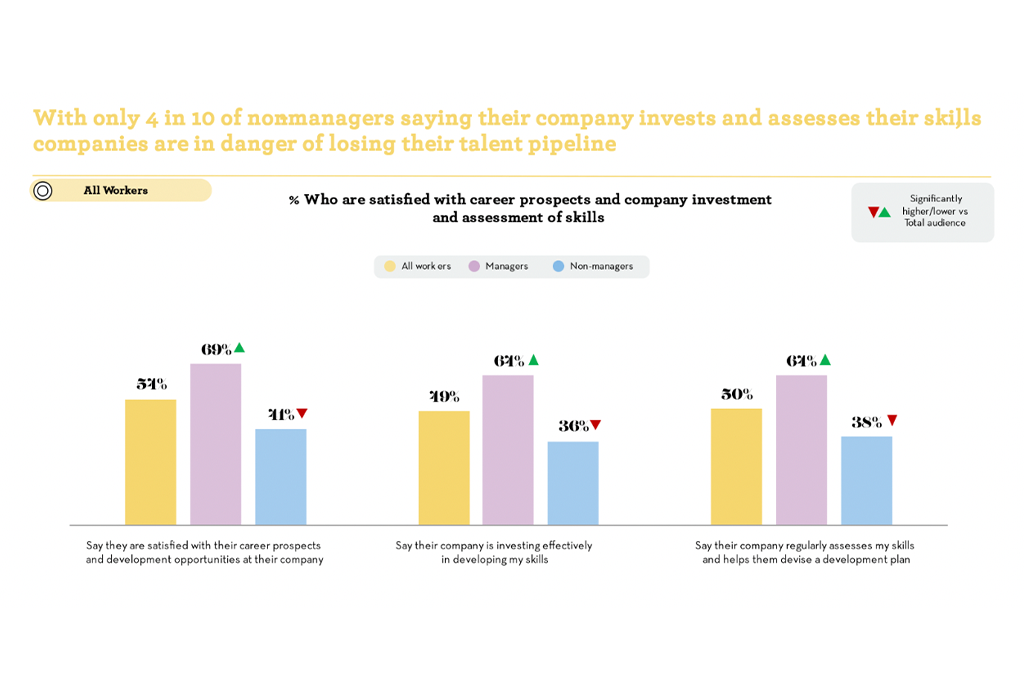
Workers crave conversations about career progression, but they’re not getting them. Nearly a quarter of the workforce have never had such a conversation in their current position (23%). And that means businesses are missing out on a golden opportunity to fill their talent pipelines. Workers who have frequent career conversations are 10 times more likely to be encouraged to apply for internal job opportunities than workers who do not have such conversations.
This brings us back to what we call the rise of the quitfluencer, in which workers who see their compatriots leaving are far more likely to do so themselves. We believe leaders have a clear opportunity here: Organisations that have frequent career conversations with workers will increase retention rates, filling positions with workers who are not only familiar with the company culture but have already demonstrated that they don’t want to quit.
During these career conversations, employers can educate workers on the benefits that qualifications and training could have on their career. This information in turn increases worker engagement; those who invest in themselves by pursuing training and certifications are still more likely to remain for the long term.
By contrast, if career conversations aren’t happening, workers miss out on being informed of or encouraged to apply for internal mobility opportunities.
A quarter of all workers who responded to our study said their mental health has worsened over the past year. Women were more concerned about their mental health, though worries were high for both. And non-managers showed more warning signs than managers. Less than half of workers believe their company is doing well when it comes to supporting mental health and wellbeing. Unfortunately, these findings have not changed much in the past two years.
Naturally, mental health concerns lead to fears of burnout—we found that one worker out of two is concerned about experiencing burnout in the future. A high proportion (36%) say they’ve suffered burnout in the past 12 months, and one out of four workers have actually left the workforce for this reason.We have addressed the burnout pandemic and the fact that leaders must do better in spotting the symptoms.
This brings us back to what we call the rise of the quitfluencer, in which workers who see their compatriots leaving are far more likely to do so themselves. We believe leaders have a clear opportunity here: Organisations that have frequent career conversations with workers will increase retention rates, filling positions with workers who are not only familiar with the company culture but have already demonstrated that they don’t want to quit.
During these career conversations, employers can educate workers on the benefits that qualifications and training could have on their career. This information in turn increases worker engagement; those who invest in themselves by pursuing training and certifications are still more likely to remain for the long term.
By contrast, if career conversations aren’t happening, workers miss out on being informed of or encouraged to apply for internal mobility opportunities.
Mental Health
A quarter of all workers who responded to our study said their mental health has worsened over the past year. Women were more concerned about their mental health, though worries were high for both. And non-managers showed more warning signs than managers. Less than half of workers believe their company is doing well when it comes to supporting mental health and wellbeing. Unfortunately, these findings have not changed much in the past two years.
Naturally, mental health concerns lead to fears of burnout—we found that one worker out of two is concerned about experiencing burnout in the future. A high proportion (36%) say they’ve suffered burnout in the past 12 months, and one out of four workers have actually left the workforce for this reason.We have addressed the burnout pandemic and the fact that leaders must do better in spotting the symptoms.
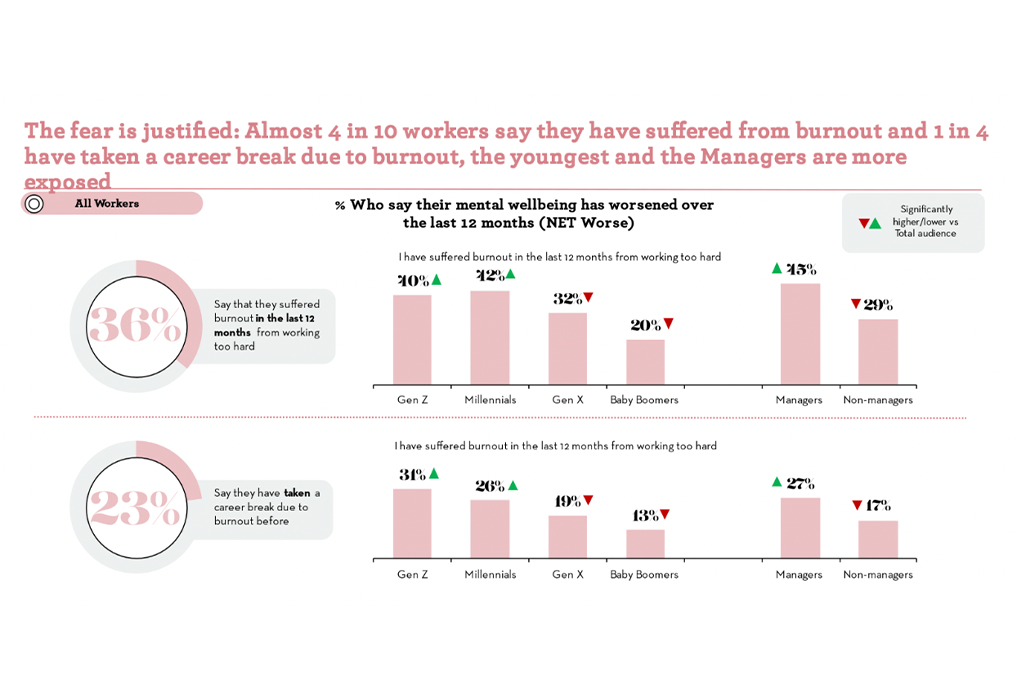
There is differentiation to be seized here by progressive companies; if employers can identify the signs of, and address, worker burnout, we believe there is a chance that fewer workers will feel compelled to take a career break. (We discussed this topic in a recent blog post.)
So what should employers do to help welcome workers back following a career break necessitated by burnout? Flexibility and autonomy in the worker’s schedule are two keys, we have found.
While helping post-burnout workers is essential, even more important is reducing burnout in the first place. Here there are many proactive steps leaders can and should take. For example, workers should be strongly encouraged to take the annual leave they’re entitled to—only about 30% do so today. Workers should also be encouraged to take sick days when they feel mentally unwell, not just physically unwell. Currently only 17% of workers feel comfortable doing this. Businesses must also establish a culture of trust.
An overall satisfaction rate of nearly 70% demonstrates that globally, businesses have made many positive strides in keeping workers engaged. However, our latest research includes several red flags that leaders must address. Chief among these, we believe, are the widening gaps between not only desk and non-desk workers, but managers and non-managers as well.
Forward-looking businesses, knowing that skills and worker shortages are unlikely to go away anytime soon, would do well to address these gaps as they seek to attract and retain top talent.
To register for our 2022 Global Workforce of the Future webinar, click here
So what should employers do to help welcome workers back following a career break necessitated by burnout? Flexibility and autonomy in the worker’s schedule are two keys, we have found.
While helping post-burnout workers is essential, even more important is reducing burnout in the first place. Here there are many proactive steps leaders can and should take. For example, workers should be strongly encouraged to take the annual leave they’re entitled to—only about 30% do so today. Workers should also be encouraged to take sick days when they feel mentally unwell, not just physically unwell. Currently only 17% of workers feel comfortable doing this. Businesses must also establish a culture of trust.
Conclusion
An overall satisfaction rate of nearly 70% demonstrates that globally, businesses have made many positive strides in keeping workers engaged. However, our latest research includes several red flags that leaders must address. Chief among these, we believe, are the widening gaps between not only desk and non-desk workers, but managers and non-managers as well.
Forward-looking businesses, knowing that skills and worker shortages are unlikely to go away anytime soon, would do well to address these gaps as they seek to attract and retain top talent.
To register for our 2022 Global Workforce of the Future webinar, click here

